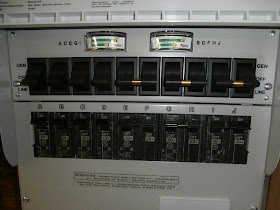I've been going through the mental exercise of trying to determine if we could use a generator as a backup source of electrical power for the house. This led me to map out all of our circuits in the house, and then try to think of essential circuits, and alternative options for those essentials. Here's a picture of my newly labeled main panel:
Doing all that research led me to think a backup generator seemed to be only half a good idea. The other half of the good idea is a manual transfer switch. Couple the two ideas together, and it was a good insurance policy for future power outages.
I found a Reliance Protran 2 manual transfer switch on Ebay for about half the price of new. It was scratch and dent, but only one little flake of paint chunked off. It has slots for 10 circuits, or up to 5 double pole circuits.
Wiring it up was a piece of cake. The difficult part was simply deciding which circuits were the essential circuits. That, and how I would use those circuits during certain times of day/night or summer/winter to balance the electrical loads.
The input of the transfer switch is this power inlet box. I ran a big fat wire between this box and the transfer switch with the great help of Kiddo #2 - he pushed and I pulled. The portable generator plugs into this exterior box, and powers up the transfer switch.
The portable generator is this Generac XT8000e. I bought it on Craigslist for about 60% of new, and it only had 1.2 hours of use on it. It should deliver up to 8000 continuous watts and up to 10,000 watts of surge power.
I hooked up my Kill-A-Watt meter to the generator and found it produces 63 Hz and 118VAC with no load. I've gotta ask my work buddy electricians about this frequency deviation. I think it will work just fine.





Hey Dan, other than your clocks running about 3 minutes fast per hour, it probably won't hurt anything. You can simply tweak the governor spring tension to try to hit your 60 hz by dropping the rpm down. It likely has a screw adjustment.
ReplyDeleteReuben